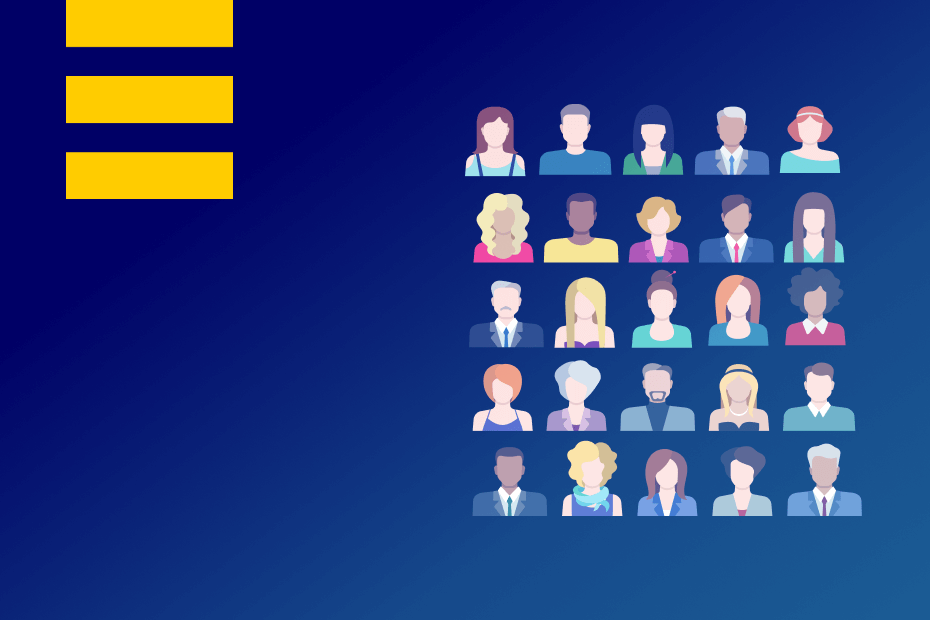
In North America and Europe, shoppers want brands to personalize their experiences based on their purchase history (26%) and interests (21%). That said, knowing your customer improves your relationship and leads to a longer lifetime value (LTV). This article focuses on understanding behaviors, sentiments, and preferences to personalize the customer journey. I.e., the three pillars that underly all successful customer journeys.
How to understand behaviors to personalize the customer journey
Behavior segmentation
Behavioral segmentation is a customer segmentation based on customers’ behavioral patterns as they interact with a company or make a purchasing decision. It allows businesses to divide customers into groups according to their knowledge of, attitude towards, use, or response to a product, service, or brand.
Behavior segmentation reflects how your customers decide to purchase from you. Although you need to observe how an individual makes these decisions, there are also common patterns in this behavior. For instance, the COVID 19 pandemic has changed the way customers make purchases. Due to the pandemic, behavioral patterns have shifted from a physical to a digital world. For instance, grocery shopping is often done online, and since many gyms got closed, the demand for exercising at home has risen.
You can segment behavior in several ways. For example, occasion-oriented behavioral segmentation is when a customer purchases a product for a specific occasion. It may then be repeated or never happen again. Usage-oriented segmentation observes the number of times the consumer uses the product, whether heavy, moderate, or minor. Loyalty-oriented segmentation focuses on customer retention rates. When the brand has a high level of loyalty, it does not have to worry about acquiring new customers. Finally, benefit-oriented segmentation relates to the benefits that people look for in a product. E.g., availability, different varieties, or prices that meet their needs.
Habits can form when a consumer associates a specific behavior with a particular context. Eventually, that behavior can become automatic. To help turn behaviors into habits, companies should identify the contextual cues that drive behaviors. Such a cue can be a particular task, time of day, or object placement. For example, more consumers keep hand sanitizer and disinfectant wipes near entryways for easy access and as a reminder to clean hands and surfaces. Product packaging and marketing that reinforces the put-it-by-the-door behavior can help consumers sustain the habit. A brand’s communications must align with its purpose; otherwise, the messages won’t ring true. Testing marketing messages among a diverse group of consumers, in the context the messages will appear, could help prevent costly missteps.
By actively listening to customers, you can better understand their behaviors; thus, you can provide a tailored customer journey. You can achieve this technically by creating targeted audience segments. For Salesforce Marketing Cloud users, an app like DESelect Segment can be extremely handy when creating no-code segments.
How to understand preferences to personalize the customer journey
Preference centers on the website
What are preference centers?
A preference center allows your email subscribers to change their subscription details quickly. Preference centers may offer a subscriber the ability to opt-in or unsubscribe from different email streams. Also, they can choose the frequency of emails they want to receive.
These are the three things you must keep in mind when enabling a preference center:
- Interests: Not every email you send will be relevant to every audience member. Let users self-segment and choose products and content relevant to them.
- Frequency: A significant contributor to unsubscribes is frequency fatigue – too many emails. Give users control over how much they want to hear from you: daily, weekly, monthly, or quarterly. We’ve written an article on avoiding the marketing pressure, which you can read here.
- Channels: Improve your user experience by using the tools they use: mail, mobile app, and or SMS. Allow them to choose the channels through which you can communicate.
After creating the preference center, double-check you’ve aligned data flows to avoid incorrect channel communications.
Another reason to improve your preference centers is that third-party data is out. It’s essential to leverage the first-party data more than ever. Read our article on personalization data here and learn about the differences between first, second, and third-party data.
The underlying driver to create a preference center is to let your customers highlight their interests and tailor the content to individual needs. To do so requires marketers to have the vision and specific technical skills to make it happen.
How to understand sentiments to personalize the customer journey
Sentiment analysis, otherwise known as opinion mining, determines the emotional tone behind a series of words. We use it to understand an online mention’s attitudes, opinions, and emotions.
How do marketers use sentiment analysis?
To offer insight into the product mix, we can analyze news mentions indicating perceptions of a company’s product quality, service quality, performance, and value. Customers can systematically use sentiment analysis to utilize reviews when making purchase decisions.
Data monitoring is immensely beneficial for marketers. Conversations among like-minded friends and connections provide valuable insight for targeting and positioning. Positive comments can turn into customer testimonials for use in retailing and promotions. Comments about competitors serve as competitive intelligence. While developing a detailed database, analysts can monitor results, synthesizing thousands of comments to create more insights.
You can automate accurate sentiment gauging. The data volume creates an information overload for most companies using research and social media monitoring. The answer is automation, but the accuracy of these systems will still be questionable.
Cultural and linguistic factors and various contexts make the coding of categorical sentiment tricky. Consider this example: A probe into attitudes regarding Moby Dick revealed a positive sentiment score from 89% of tweets about the book. But some tweets may have been incorrectly categorized. A tweet reading “Moby Dick was incredible! Spare a thought for the needless hunting and killing of whales, though.” was coded negatively. The software read “hunting and killing” as a negative indicator. Of course, a human could understand this positive statement for the book, while the software could not. Linguistic nuances make for accuracy issues for this software. Another example could be a lingerie brand described as “something wicked” and subsequently classified as negative. (source: https://www.michaelsolomon.com/consumer-insights/sentiment-analysis/)
Categorical data is also an issue. It isn’t easy to gauge who comments (which segments they represent) regarding geographic and demographic descriptors. Using URL, IP address, or language, you can identify conversation origin, though all of these approaches have flaws. URL and IP addresses are far from accurate (consider Facebook, for instance, with a worldwide user base). The same goes for language indicators, equally inaccurate as they are.
There’s a lot of talk on the internet about your brand, some good and some bad. Sentiment analysis allows you to monitor the emotional landscape constantly, proactively managing your organization’s image. After analyzing the words used by your customers and users, try to speak with them using their language. In that case, your brand’s voice will be more personal and humane. You will be understood and loved by your customers.
So when it comes to sentimental analysis, conclusions made solely from data insights might not be 100% accurate since many contexts can mislead machines. Hence, it is necessary to involve human analysis in this process.
Conclusion
It’s essential to know how to use your data to streamline and personalize customer conversations. Digital data-gathering and monitoring techniques such as mobile diaries, social-media listening, AI-powered language optimization tools will be vital for companies to understand emerging behaviors and contextual cues. Those insights generate new organizational thinking validated through larger-scale surveys and well-structured in-market testing. Companies can then refine their product offerings and marketing messages accordingly. To send personalized campaigns, you can build sensible audience segments.
There are tools in the market that make segmentation and personalization easier for marketers. Discover a no-code segmentation solution DESelect Segment, that helps marketers create unique customer journeys in Salesforce Marketing Cloud.
- How to understand behaviors to personalize the customer journey
- How to understand preferences to personalize the customer journey
- How to understand sentiments to personalize the customer journey
- Conclusion
Latest Articles
-
Platform-Agnostic Solutions: The Future of Higher Ed Marketing and Data Strategy
Platform-Agnostic Solutions: The Future of Higher Ed Marketing and Data Strategy The higher education sector is rapidly evolving, driven by shifting student expectations, digital transformation, and the constant pressure to do more with less. As universities and colleges invest in marketing, enrollment, and student success technologies, a critical debate has emerged: Should institutions embrace closed, […]April 29, 2025 -
Martech Needs Alignment with People and Processes in Higher Education
Martech Needs Alignment with People and Processes in Higher Education The higher education landscape is evolving rapidly, driven by shifting student expectations, increased competition, and digital transformation. In this environment, marketing technology (martech) has emerged as a powerful enabler for institutions seeking to attract, engage, and retain students. However, a persistent challenge remains: over-reliance on […]April 29, 2025 -
Organizational Clarity Drives Success in Higher Education Marketing
Organizational Clarity Drives Success in Higher Education Marketing As colleges and universities face mounting pressures from declining enrollments, shifting student expectations, and increased public scrutiny, the need for clear roles, structured processes, and strategic alignment within marketing and communications teams has never been greater. This blog explores how organizational clarity transforms marketing operations in higher […]April 29, 2025 -
AI Tools in Higher Education: The Challenge of Data Model Nuances
AI Tools in Higher Education: The Challenge of Data Model Nuances Artificial intelligence is rapidly reshaping the higher education landscape, promising transformative gains in efficiency, insight, and personalization. From predictive analytics that forecast student success to generative AI tools that automate administrative and instructional tasks, institutions are racing to harness these innovations. Yet, as AI’s […]April 29, 2025









